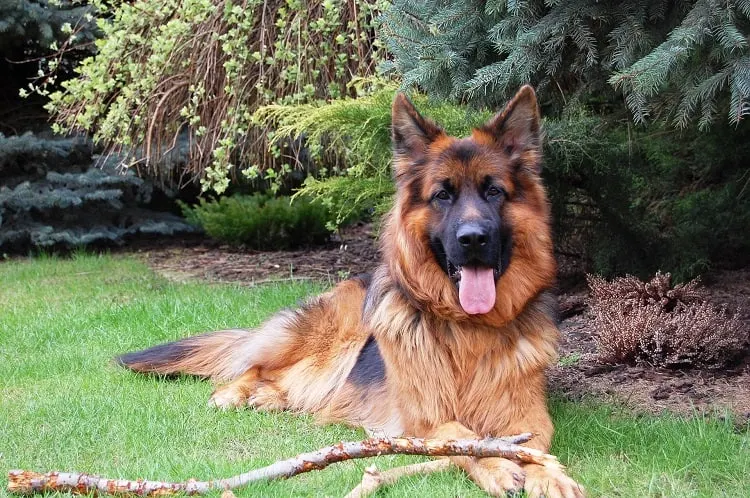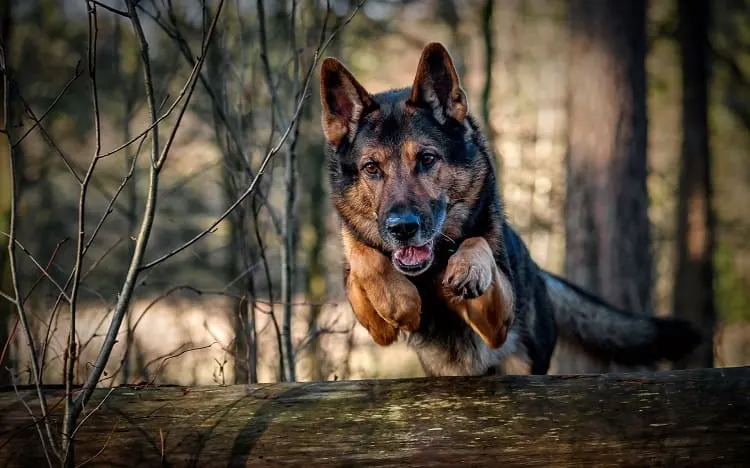Muscle Fiber Types in German Shepherd Dogs
The German Shepherd is a high-energy breed, needing a good amount of daily physical exercise to keep its muscles strong and healthy.
Lack of enough exercise can make these dogs sluggish, and weak, affecting their physical health and overall performance.
If you own a German Shepherd and want to ensure they remain healthy and fit for years to come, this handy guide on the muscles of the German Shepherd is for you.
Learn how much muscle mass German Shepherds should have and how to prevent losing it. We also discuss some of the best exercises for your dog to easily rebuild muscles. Let’s dive in!
How Much Muscle Does the German Shepherd Have?

Although it is difficult to determine exactly how much muscle and strength a German Shepherd has, its bite force can give you a good idea of its overall strength.
Bite force refers to the amount of pressure exerted when a dog bites down.
German Shepherds have a bite force of 238 pounds per square inch (PSI), which is powerful enough to break bones.
Their bite force is more potent than humans (150 to 200 PSI), making them one of the strongest dog breeds.
Can a German Shepherd Lose Muscle Mass?

In 2016, a study titled Evaluation of Muscle Fiber Types in German Shepherd Dogs of Different Ages was conducted to measure the percentage of type I and type II muscle fibers in male and female German Shepherds.
These muscle fibers make up the gluteus medius muscles that are located on the sides of the hips.
The study was done with standardized care in different age groups of the breed using enzyme histochemical methods.
The researchers collected muscle samples from the gluteus medius muscle of forty clinically healthy dogs through a percutaneous needle muscle biopsy.
They analyzed the muscle samples using the enzyme histochemical method. They further studied the proportion and correlation between the number of types I and II fibers.
For this, they used the parameters of age groups, weight, the relationship between sex and age group, and the correlation between the sexes of German Shepherds.
No significant difference was found in relation to the fiber types for the parameters of weight, age group, and age of the female canines.
The connection between the ages of the males suggested a rise in the proportion of type I muscle fibers and a fall in the proportion of type II fibers.
Simply put, there was a jump in the ratio during the aging process. The study concluded that type II fibers decreased as the age of male dogs increased.
There was not much variation in the ratio of type I and II fibers in correlation to the weight of the dogs.
The study indicated a relationship between the age and proportion of muscle fibers in male German Shepherds.
It was also found that the size of type II fibers began to reduce in the muscles of dogs at seven years of age.
How to Prevent Muscle Loss

Muscle atrophy or muscle loss occurs due to reduced physical activity, aging, or illnesses, like hip dysplasia.
The research study mentioned above found that when muscles are used regularly and thoroughly, type I fibers can increase in German Shepherds, thereby preventing muscle loss.
To train the core muscles of your puppy or adult and help them meet the breed standard, make sure they have regular exercise. Play games and take them on a long walk every day.
Early training can do wonders for your dog’s physical health and well-being. Also, German Shepherds love running around and playing. Coaxing your pet into regular exercise should not be difficult.
Give your pet good-quality dog food, clean drinking water, and the right nutritional supplements. This will support to your dog’s joints and keep them strong and healthy.
Your pet should also get enough sleep in a clean and comfortable spot. Maintaining a healthy routine will ensure stronger muscles in your German Shepherd, helping them to stay balanced and active.
Here are a few simple exercises that will prevent muscle loss in your German Shepherd:
- Walking, running, and swimming
- Obedience and agility training
- Doggie pushes, squats, and tug-of-war
- Flirt pole and balance exercises such as walking on a trampoline or foam, standing on a wobble board, or sitting on a balance ball
Get the right exercise equipment and ensure that you and your dog learn how to use them properly to prevent accidents and injuries.
Patience is key – take the time to teach your pet the ins and outs of the new equipment before diving in.
If your dog has severe muscle loss or you wish to receive expert advice from a professional before you change its daily routine, visit a veterinary clinic and consult with a vet.
Rebuilding Muscle

If you have an older German Shepherd that is quite weak, it will take more time and effort to get them back into shape.
While building muscles for a puppy or younger dog is relatively easy, rebuilding muscle mass for an adult dog is much more complicated.
You will need to avoid certain sports and activities as they can be dangerous for older dogs. Some of the physical activities to include:
- Long walks and lateral walking
- Obedience and tracking training
- Fetching, swimming, and playing on the beach
Conclusion
Unlike other breeds, German Shepherds require a lot of physical activity to keep them strong and muscular.
Owners should ensure their dog has a regular exercise to help maintain a healthy body size and weight.
You should also take care of your dog’s food, sleep, and other nutritional needs to help it stay fit.
If your dog shows any weakness or illness, take it to a veterinary clinic and get medical help immediately.
Resources:




















